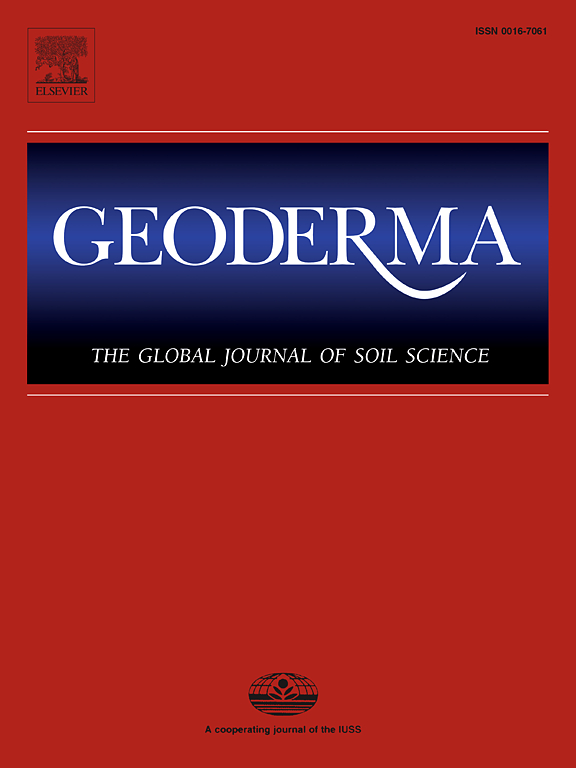National-scale mapping topsoil organic carbon of cropland in China using multitemporal Sentinel-2 images
IF 5.6
1区 农林科学
Q1 SOIL SCIENCE
引用次数: 0
Abstract
Precise monitoring of soil organic carbon (SOC) is urgently needed in agricultural regions to tackle global challenges like food security, water regulation, land degradation, and climate change. Remote sensing technology has emerged as a powerful method for detecting variations in SOC at localized scales. However, its application on a broader, national scale faces limitations, especially in countries like China, where soil landscapes exhibit significant diversity. This study aimed to couple bare soil reflectance and conventional environmental covariates to map Chinese cropland SOC content at a 10-m spatial resolution. First, a new time-series bare soil extraction method, the Two-Dimensional Bare Soil Separation Algorithm, was applied, utilizing Sentinel-2 images from 2018 to 2022 to generate a continuous spectral reflectance composite. Then, nine indices with the strongest correlation to SOC were selected. Additionally, a list of environmental covariates was prepared based on SCORPAN model. Finally, bootstrapping random forest models were fitted using the covariates selected through forward recursive feature selection (FRFS), and the spatial prediction SOC map was created. The results indicated that the framework was suitable for mapping SOC in croplands of China, with the best model using remote sensing indices and environmental covariates selected through FRFS achieving an R2 of 0.62, an RMSE of 4.84 g kg−1, and an uncertainty depicted by a 90 % prediction interval range of 17.88 g kg−1. The final map showed that the Northeast China had the highest SOC content in cropland. Climatic conditions, position, and remote sensing indices are key covariates in national-scale SOC estimation. This study can be easily implemented across broad areas for the prediction of SOC with computational efficiency. The 10-m spatial resolution SOC map of China contributes to land management and the development of policies for precision agriculture.
基于Sentinel-2多时相影像的中国农田表层土壤有机碳制图
农业地区迫切需要精确监测土壤有机碳(SOC),以应对粮食安全、水资源调节、土地退化和气候变化等全球性挑战。遥感技术已成为在局部尺度上检测有机碳变化的有力方法。然而,它在更广泛的全国范围内的应用面临着局限性,特别是在中国这样的土壤景观具有显著多样性的国家。本研究旨在耦合裸地土壤反射率和常规环境协变量,在10 m空间分辨率下绘制中国农田有机碳含量图。首先,采用一种新的时间序列裸土提取方法——二维裸土分离算法,利用2018 - 2022年Sentinel-2遥感影像生成连续光谱反射率复合图像。然后选取与有机碳相关性最强的9个指标。此外,基于SCORPAN模型编制了环境协变量列表。最后,利用前向递归特征选择(FRFS)选择的协变量对自举随机森林模型进行拟合,建立空间预测SOC图。结果表明,该框架适用于中国农田土壤有机碳图谱,利用遥感指标和环境协变量通过FRFS选择的最佳模型R2为0.62,RMSE为4.84 g kg - 1,不确定性为90%,预测区间范围为17.88 g kg - 1。结果表明,东北地区土壤有机碳含量最高。气候条件、地理位置和遥感指标是国家尺度土壤有机碳估算的关键协变量。该研究可以很容易地应用于广泛的领域,以计算效率预测SOC。中国10 m空间分辨率土壤有机碳地图为精准农业的土地管理和政策制定做出了贡献。
本文章由计算机程序翻译,如有差异,请以英文原文为准。
求助全文
约1分钟内获得全文
求助全文
来源期刊

Geoderma
农林科学-土壤科学
CiteScore
11.80
自引率
6.60%
发文量
597
审稿时长
58 days
期刊介绍:
Geoderma - the global journal of soil science - welcomes authors, readers and soil research from all parts of the world, encourages worldwide soil studies, and embraces all aspects of soil science and its associated pedagogy. The journal particularly welcomes interdisciplinary work focusing on dynamic soil processes and functions across space and time.
 求助内容:
求助内容: 应助结果提醒方式:
应助结果提醒方式:


